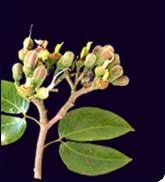My students nicknamed me "Turmeric
Doctor" so I might say a few more words about this wonderful
herb and help some of you to zero in on important issues
in both food preparation and herbal supplementation.

First of all, turmeric is a culinary
spice, the one that gives curry its distinctive yellow color. The
turmeric you find in powdered form as a spice
has been boiled before being ground. The color may
be anything from yellow to almost orange.
Turmeric is a member of the ginger family. Its cousins,
ginger and galangal, are also culinary spices but they are
more tingly than turmeric. The part of the plant used
is the tuber. It grows in tropical climates. In
Hawaii, it is called olena and the fresh root is pounded
and used as a wash for athlete's foot and other fungal infections.
Energetically, turmeric is spicy but not nearly as hot as
ginger or chili. It is also a little bitter and astringent,
making it quite different from hotter spices. In Ayurvedic
medicine, there are six tastes. I discuss these at
great length on doshabalance.com.
There is also a six-hour lecture on this subject on tape,
available on kitchendoctor.com. Those are also my web
sites.
Energetics
Many people are just learning to understand energetics
and they may have started through a sort of back door by
studying pH. The Macrobiotic people did quite a bit to heighten
awareness of the acid-alkaline balance, but they did not present
a complete context. Still, one has to begin somewhere.
Chinese medicine recognizes five tastes and Ayurveda has
six, astringent being the one "missed" by TCM because
it is combined with the sour taste. The taste of a food
is a clue to the pharmacology of the food. We all know
that sweet food produces weight gain but did we know that the
energetics of the sweet taste are heaviness, moisture, and
coldness, the exact opposite of pungent foods? Spices
are light, dry, and warm. In theory, and it is only
a theory, you can take something as sweet as ice cream and
balance the energetics so that mucus and weight gain are
not consequences of excess consumption of this dessert.
For instance, I make an ice cream with slices of ginger,
ground cardamon, carrot juice, and milk plus sweetener. It
is energetically balanced. It's
also delicious. However, I don't want to digress; I
want to try to stay on the subject. Besides balancing,
spices promote metabolism of otherwise
hard to digest foods. For instance, turmeric is great
emulsifier and it helps to digest fats; it also keeps oils
from turning rancid. When you separate foods from a
vital context, they are harder to understand, but let's try
to fit a complex puzzle together.
Heavier foods promote growth. They are necessary for
the replacement of worn out tissues and crucial for fertility
and longevity. In experiments with animals, very heavy
supplementation with turmeric resulted in zero negative side
effects, i.e., "safe at any dose" but there was
also zero reproduction. Obviously, if at culinary
doses, turmeric prevented conception, India would not have
a billion people. Likewise,
if it prevented cancer at the level used in curries, India
would not have any cases of cancer. This said, turmeric
is still a "food
grade dietary supplement" that is remarkably safe at
practically any dosage.
Turmeric, however, is such a good emulsifier that it eats
through plastic bags. I have also had many plastic caps on jars
melt. They look like Salvatore Dali paintings. The
precious oils in the spices have this property so they really
help with sugar and fat metabolism, weight gain, and raging
reproductive hormones. What is important about this for
mold sufferers is that fungi can produce xenoestrogens that
throw your body into chaos. Certain herbs take some of
the pressure off while at the same time acting as antifungal
agents. Nearly all these herbs are hot.
Now, the question is what form to take them since the amounts
used in cooking may not be sufficient to arrest the havoc. Many
supplements have additives, binders, or production processes
that make them unsuitable for people suffering from mold
infection. You
want the purest form possible. In the case of turmeric,
you can buy the fresh root, overnighted from Hawaii, or the
powder made from organically grown turmeric, but you surely
do not want a product that is laced with other "stuff." You
could also use an alcohol extract. I would argue
that whatever the hypothetical risks of alcohol, they are
minimal when balanced by a spice. This said, we use
organic, non-GMO grain alcohol in all our formulas and there
are a few others following similarly conscious practices.
I sent an email recently about artisan manufacturing practices. Turmeric
is another excellent example of an herb that requires visual
inspection before use. If this important step is skipped,
there could be contaminants in the final product. I
am really urging you to take the time to source good quality
products because the result could be otherwise be disappointing.
Ingrid Naiman
12 October 2006





Sacred
Medicine Sanctuary
Copyright by Ingrid Naiman
2005
No part of this site may
be reproduced or published in any form or on any other web
site without written
permission from the site owner.




